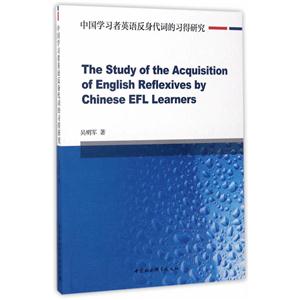-
>
心灵元气社
-
>
县中的孩子 中国县域教育生态
-
>
(精)人类的明天(八品)
-
>
厌女(增订本)
-
>
这样学习才高效/杨慧琴
-
>
心理学经典文丛:女性心理学
-
>
中国文化5000年
中国学习者英语反身代词的习得研究 版权信息
- ISBN:9787520301237
- 条形码:9787520301237 ; 978-7-5203-0123-7
- 装帧:暂无
- 册数:暂无
- 重量:暂无
- 所属分类:>>
中国学习者英语反身代词的习得研究 本书特色
本研究的测量工具是基于故事的真值判断任务。每个故事由2-5句组成,后面有一个含有反身代词的句子。故事为受试的判断提供语境,在他们阅读故事后,判断故事和句子是否相符。研究中的40个实验句,分别考察反身代词的主语倾向性、局部性和成分统领等三个约束特性,分为五种句型:考察主语倾向性的单子句、考察成分统领的单子句,以及考察局部性的限定性双子句、非限定性双子句和含有具象类限定词短语(PRNP)的单子句。为了克服传统的纸笔答题的缺点,我们采用E-prime对测试内容进行编程,实验中的40个故事完全*呈现,受试只需按Y键(代表相符)和N键(代表不符),即可做出判断。根据E-prime自动记录的正确率,研究三组学习者在不同句型及其子类型中反身代词的约束特性习得。
中国学习者英语反身代词的习得研究 内容简介
本书主要探讨英语教学中中国学习者能否正确地理解英语的反身代词。书稿运用“语段理论”和“接口假说”从两个不同视角对局部性差异进行了合理的解释。此外,书稿还运用接口假说对很多中国学习者不能习得宾语约束进行了解释。研究的结果表明,低级组不能区分接口,而中级组和高级组能区分内接口和外接口,发展了接口假说。
中国学习者英语反身代词的习得研究 目录
摘要
Abstract
Chapter One Introduction
1.1 Introduction
1.2 Referentiality in natural language
1.2.1 Referentiality in human language
1.2.2 Significance of the research on referentiality
1.3 Referential characteristics of reflexives in English and Chinese
1.3.1 Similarities in referential properties
1.3.2 Distinct referential characteristics
1.3.2.1 The difference in locality requirement
1.3.2.2 The difference in orientation
1.3.3 The logical problem with the acquisition of English reflexives
1.4 UG and second language acquisition
1.5 Organization of the dissertation
Chapter Two Theoretical Foundations: The Binding Theory
2.1 Introduction
2.2 Types of determiner phrases
2.3 The standard binding theory
2.3.1 Binding
2.3.2 Principle A of the standard binding theory
2.3.3 Problems with the standard binding theory
2.4 Modified versions of the standard binding theory
2.4.1 Binding Principle A of the parameterized approach
2.4.1.1 Governing Category Parameter and Proper Antecedent Parameter
2.4.1.2 Criticisms of the parameterized approach
2.4.2 Binding Principle A of the LF-movement approach
2.4.2.1 Account of the long-distance binding
2.4.2.2 Predictions for language acquisition
2.4.2.3 Problems with the LF-movement approach
2.4.3 Binding Principle A of the relativized SUBJECT approach
2.4.3.1 Binding Principle A
2.4.3.2 Long-distance effects
2.4.3.3 Subject orientation
2.4.3.4 Predictions for language acquisition
2.4.3.5 Problems with the relativized SUBJECT approach
2.5 The binding theory in the Minimalist Program { MP }
2.5.1 Overview of the MP: Simplicity
2.5.2 The phase theory
2.5.3 Mechanisms of binding in the phase theory
2.5.3.1 Derivational Binding Principle A
2.5.3.2 Binding through q~-feature matching
Chapter Three Previous Empirical Studies on Reflexives
3.1 Introduction
3.2 Studies on child language acquisition of reflexives
3.2.1 L1 research within the framework of the parameterized approach
3.2.1.1 Acquisition of reflexives with the local binding in the NL
3.2.1.2 Acquisition of L1 reflexives with LD binding
3.2.2 Reflexive and pronoun asymmetry
3.2.3 Evidence supporting the relativized SUBJECT approach
3.2.4 Developmental processes
3.3 Studies on second language acquisition of reflexive binding
3.3.1 Studies within the framework of the parameterized approach
3.3.1.1 Finer & Broselow { 1986}
3.3.1 2 Finer {1991}
3.3.1 3 Thomas 11989 and 1991a)
3.3.1 4 Cook {1990}
3.3.1 5 Hirakawa {1990}
3.3.1 6 Eckman (1994}
3.3.1 7 Lakshmanan & Teranishi 11994}
3.3.2 Studies within the LF-movement approach
3.3.2.1 Christie {1992)
3.3.2.2 Thomas (1995}
3.3.2.3 Yip &Tang {1998}
3.3.2.4 Jiang {2009}
3.3.3 Studies within the relativized SUBJECT approach
3.3.3.1 Bennett {1994}
3.3.3.2 MacLaughlin { 1998 }
3.3.3.3 Wells {1998}
3.4 An alternative account of the problematic acquisition: the Interface Hypothesis (IH}
3.5 Summary
Chapter Four Experimental Design and Method
4.1 Introduction
4.2 The mixed RM ANOVA design
4.3 Procedure
4.4 Materials
4.4.1 Sentence Type 1 : C-command
4.4.2 Sentence Type 2 : Orientation
4.4.3 Sentence Type 3 : Locality in the finite condition
4.4.4 Sentence Type 4 : Locality in the nonfinite condition
4.4.5 Sentence Type 5 : Locality in the PRNP condition
4.5 Participants
4.6 Research questions
Chapter Five Data and Data Analyses
5.1 Introduction
5.2 Preliminary analysis
5.2.1 The descriptive statistics
5.2.2 The results of the mixed RM ANOVA
5.3 Developmental patterns across binding properties
5.3.1 The low group
5.3.1.1 Aggregate results
5.3.1.2 Individual results
5.3.2 The mid group
5.3.2.1 Group data
5.3.2.2 Individual data
5.3.3 The high group
5.3.3.1 Group results
5.3.3.2 Individual data
5.4 Developmental patterns of binding properties through proficiency levels
5.4.1 C-commanding requirement
5.4.1.1 Aggregated data
5.4.1.2 Individual results
5.4.2 Orientation
5.4.2.1 Aggregated data
5.4.2.2 Individual results
5.4.3 Locality : The finite condition
5.4.3.I Aggregated results
5.4.3.2 Individual data
5.4.4 Locality: The nonfinite condition
5.4.4.1 Aggregated results
5.4.4.2 Individual data
5.4.5 Locality: The "PRNP condition
5.4.5.1 Aggregated results
5.4.5.2 Individual data
Chapter Six Discussion
6.1 Introduction
6.2 Main Results
6.2.1 Development across binding properties
6.2.2 Development through proficiency
6.3 Crosslinguistic influence
6.3.1 Positive transfer hypothesis
6.3.2 The two-stage transfer: Accounting for the group differences
6.3.3 Combinatory transfer of morphology of reflexives and AGR
6.4 Direct accessibility of Universal Grammar
6.4.1 L2 interlanguage grammars falling within the range sanctioned by UG
6.4.2 Constraints of UG on interlanguage grammars
6.4.2.1 The LF-movement account
6.4.2.2 The parameterized approach
6.4.2.3 The relativized SUBJECT analysis
6.5 Asymmetries in locality: A phase-based approach
6.5.1 Advanced L2 learners
6.5.1.1 Reflexives in the vP Phase
6.5.1.2 The DPphase
6.5.2 Intermediate L2 learners
6.5.3 Low proficiency learners
6.5.3.1 Completeness of the vP phase
6.5.3.2 Head of the phase: vvs.D
6.6 Interface categories involved in Binding Principle A
6.6.1 Acquisition oft-commanding condition: Pure syntax
6.6.2 Acquisition of locality in the nonfinite clause: Syntax-lexicon interface
6.6.3 Acquisition of locality in the PRNP condition: Syntax-semantics interface
6.6.4 Acquisition of the object DP binding: Syntax-discourse interface
Chapter Seven Conclusion
7.1 Introduction
7.2 Developmental patterns of L2 learners' acquisition of reflexives
7.3 Theoretical and empirical implications
7.4 Suggestions for future research
Notes
References
Appendix: Individual results
Abbreviations
中国学习者英语反身代词的习得研究 作者简介
吴明军,上海交通大学博士,师从王同顺教授,专业为外国语言学及应用语言学。现为重庆工商大学外国语学院教师,副教授。研究方向为二语习得和加工,句法学等。在《外语教学与研究》、《外国语》、《现代外语》、《外语教学理论与实践》等期刊发表论文10余篇。?2011年9月至2012年1月在美国萨姆休斯顿大学访学。
- >
伊索寓言-世界文学名著典藏-全译本
伊索寓言-世界文学名著典藏-全译本
¥9.3¥19.0 - >
巴金-再思录
巴金-再思录
¥14.7¥46.0 - >
随园食单
随园食单
¥15.4¥48.0 - >
名家带你读鲁迅:故事新编
名家带你读鲁迅:故事新编
¥13.0¥26.0 - >
莉莉和章鱼
莉莉和章鱼
¥13.4¥42.0 - >
唐代进士录
唐代进士录
¥25.5¥39.8 - >
姑妈的宝刀
姑妈的宝刀
¥9.0¥30.0 - >
罗庸西南联大授课录
罗庸西南联大授课录
¥13.8¥32.0
-
咬文嚼字二百问
¥14.2¥32 -
普通话语音史话
¥9.8¥18 -
公文写作大手笔:从小笔头到笔杆子
¥58.7¥79 -
四季汉字一岁诗
¥12¥28 -
642件可写的小事:怎么写都行:san francisco writers grotto
¥29.9¥39.8 -
中小学生读书法
¥14.7¥39.8





















